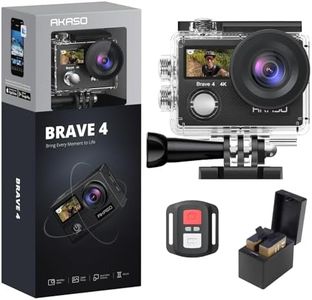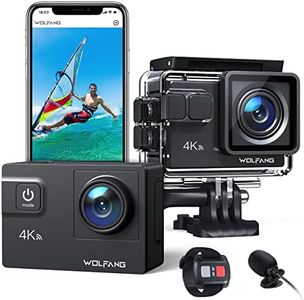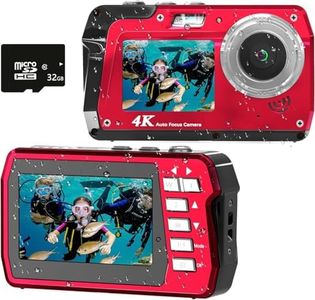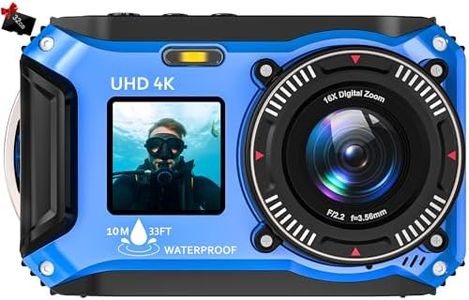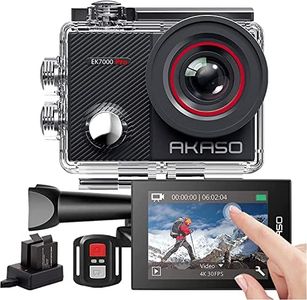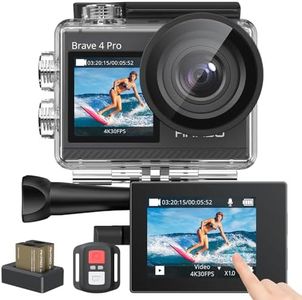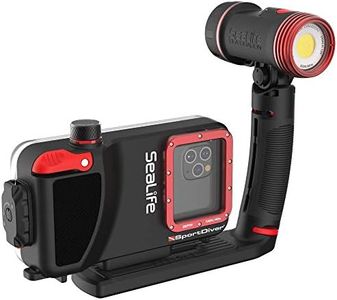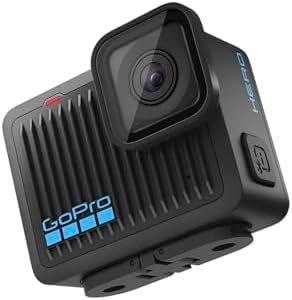We Use CookiesWe use cookies to enhance the security, performance,
functionality and for analytical and promotional activities. By continuing to browse this site you
are agreeing to our privacy policy
10 Best Dive Cameras
From leading brands and best sellers available on the web.#1
Winner
Buying Guide for the Best Dive Cameras
Choosing a dive camera is all about matching the camera's features to the conditions you'll be diving in and the type of images or videos you want to capture. A good dive camera must be durable, easy to control underwater, and capable of producing sharp, clear images in a variety of underwater lighting conditions. Before picking one, think about whether you’re a beginner or experienced diver, how deep you usually go, and whether you want primarily still shots, video, or both. Also, consider factors like portability, ease of use with gloves, and how quickly you want to access key settings while underwater.Waterproof Depth RatingThis tells you how deep you can safely take the camera underwater without damaging it. Some cameras are waterproof to shallow depths (around 10-15 meters), good for snorkeling and shallow dives, while more advanced models can handle depths of 30 meters or more, suitable for scuba diving. Very high-end or professional setups may go even deeper. Consider the maximum depth you plan to dive: pick a camera rated for slightly deeper than your typical depth to give yourself a safety margin.
Image Sensor SizeThe sensor is the part that captures light and creates your images and videos. Larger sensors typically capture more light, resulting in clearer and more detailed photos, especially in the low-light conditions found underwater. Compact cameras usually have small sensors (good for casual use and portability), while larger sensors (found in advanced compact or mirrorless cameras) offer better image quality. If you want high detail or plan to edit your photos, prioritize a larger sensor, but casual users may be satisfied with the standard small sensors.
Lens Options and Focal LengthThe lens and its focal length influence how much of the scene fits in the shot and how close you can get to your subject. Fixed lens cameras are simple and often wide enough for underwater scenes, while interchangeable lens systems give flexibility if you want to specialize (like macro or wide-angle shots). A wider lens (shorter focal length) is better for capturing large reef scenes or groups, while closer focal lengths are useful for photographing small creatures. Match your lens preference to what you most want to capture.
Manual ControlsManual controls let you adjust settings like shutter speed, aperture, and ISO, important for compensating for unique underwater lighting. Basic cameras may offer only automatic modes, which are simple but less flexible. If you're interested in advancing your underwater photography, cameras with accessible manual controls will allow you to get better, more creative shots, especially as you learn more about managing underwater light and color.
Video CapabilitiesIf you want to film underwater, check the camera's video resolution (like 1080p or 4K) and frame rates, which determine the sharpness and smoothness of footage. Basic models shoot decent HD video, while more advanced ones offer 4K and higher frame rates for slow motion. Think about how much video you want to shoot and how you intend to use or share it; casual use may not require the highest settings, while regular videographers might want more advanced capability.
Image StabilizationImage stabilization helps reduce blurriness caused by movement – common underwater, where holding a camera steady can be tough. Basic digital stabilization helps a bit, while more advanced optical stabilization systems are best for crisp images and videos. If you expect to be handholding your camera a lot or shooting on the move, stronger stabilization is a valuable feature.
Ease of Use UnderwaterLook at the camera design: large, clearly labeled buttons and a simple menu system make it easier to operate while wearing gloves or when your visibility is low. Some cameras have touch screens, but these don’t always work well underwater. If you value convenience, prioritize simple controls and good ergonomics for stress-free use during your dive.
Expandable AccessoriesSome cameras support additional accessories such as external flashes (strobes), video lights, or wet lenses. Natural underwater light drops off quickly, so external lighting can greatly improve photos. If you see yourself advancing or want to experiment with different shooting styles, pick a camera that can be expanded with quality underwater accessories.




